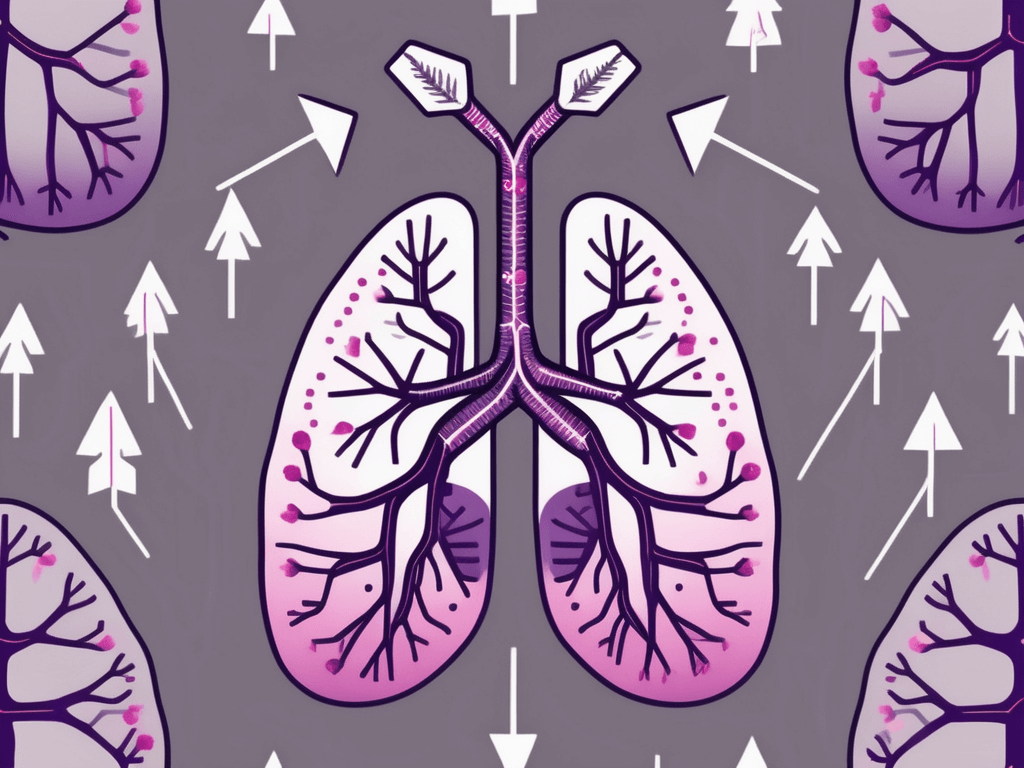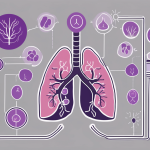Lung metastasis, the spread of cancer cells from other parts of the body to the lungs, presents significant health challenges. This article elucidates the process of metastasis, detailing how cancer cells navigate the bloodstream or lymphatic system to settle in the lungs, where they adapt to the unique environment and establish new tumors. Symptoms, diagnostic procedures, and treatment options for lung metastasis are explored, emphasizing the importance of early detection and informed decision-making for improved outcomes and quality of life.
Lung metastasis refers to cancer that has spread to the lungs from other parts of the body. It is a complex process that can have significant impacts on a person’s health and quality of life. By understanding the causes, recognizing the symptoms, and exploring the available treatment options, individuals diagnosed with lung metastasis can make informed decisions about their care and improve their overall well-being.
What is Lung Metastasis?
When cancer cells break away from the primary tumor site and travel through the bloodstream or lymphatic system, they can potentially settle in the lungs and form new tumors. This secondary spread of cancer to the lungs is known as lung metastasis. These secondary tumors can grow and interfere with the normal functioning of the lungs, leading to a range of symptoms and complications.
Defining Lung Metastasis
Lung metastasis specifically refers to cancer cells originating from other parts of the body, such as the breast, colon, or prostate, spreading to the lungs. The lungs provide an ideal environment for tumor growth due to their extensive blood supply and large surface area. As a result, lung metastasis is a common occurrence, with many different cancers having the potential to spread to this vital organ.
Lung metastasis can occur through various mechanisms. One common method is through the bloodstream, where cancer cells detach from the primary tumor and enter the circulation. As they travel through the blood vessels, some of these cells may find their way into the lungs, where they can establish new tumors. Another route is through the lymphatic system, which acts as a network of vessels that transport fluid and immune cells throughout the body. Cancer cells can enter the lymphatic system and eventually reach the lungs, forming metastatic tumors.
Once cancer cells have arrived in the lungs, they face numerous challenges in establishing themselves and growing into new tumors. The lungs are composed of a complex network of airways, blood vessels, and supportive tissues. Cancer cells must adapt to this unique microenvironment and find ways to evade the body’s immune system. They also need to establish a blood supply to sustain their growth. This process, known as angiogenesis, involves the formation of new blood vessels to deliver oxygen and nutrients to the tumor.
The Process of Metastasis
The process of metastasis involves several steps. First, cancer cells detach from the primary tumor and enter either the bloodstream or the lymphatic system. From there, they travel to other parts of the body, including the lungs. Once they reach the lungs, the cells need to adapt to the new environment and establish a blood supply to sustain their growth. Over time, these metastatic tumors can grow larger and may eventually cause symptoms or complications.
Metastasis is a complex and multifaceted process that requires cancer cells to acquire specific traits that enable their survival and growth in distant organs. These traits include the ability to invade surrounding tissues, resist cell death, and evade the immune system. Cancer cells must also be able to interact with the new microenvironment of the lungs, which is different from their original site of origin.
Once cancer cells have settled in the lungs and established a blood supply, they can grow and divide rapidly, forming new tumors. These tumors can vary in size and location within the lungs, and their growth can lead to a range of symptoms. Common symptoms of lung metastasis include persistent cough, shortness of breath, chest pain, and coughing up blood. In some cases, lung metastasis may also cause complications such as pneumonia, collapsed lung, or obstruction of the airways.
Treatment options for lung metastasis depend on various factors, including the type and stage of the primary cancer, the number and size of metastatic tumors, and the overall health of the patient. Treatment approaches may include surgery to remove the tumors, radiation therapy to target and destroy cancer cells, chemotherapy to kill cancer cells throughout the body, targeted therapy to block specific molecules involved in cancer growth, or immunotherapy to boost the body’s immune response against cancer.
In conclusion, lung metastasis is a complex process involving the spread of cancer cells from other parts of the body to the lungs. Once in the lungs, these cells must adapt to the new environment and establish a blood supply to sustain their growth. Lung metastasis can lead to a range of symptoms and complications, and treatment options vary depending on individual factors. Ongoing research and advancements in cancer treatment continue to improve outcomes for patients with lung metastasis.
Causes of Lung Metastasis
There are various primary cancers that can potentially lead to lung metastasis. Some of the most common primary cancer sites include the breast, colon, prostate, kidney, and bladder. When these primary tumors spread to the lungs, they can significantly impact lung function and overall health.
Primary Cancers Leading to Lung Metastasis
Primary cancers that often metastasize to the lungs include breast cancer, colorectal cancer, prostate cancer, renal cell carcinoma, and bladder cancer. It is important to note that any type of cancer can potentially spread to the lungs, but these cancers are more likely to do so. Timely detection and appropriate treatment of these primary cancers can help minimize the risk of lung metastasis.
Risk Factors for Lung Metastasis
Several risk factors can increase the likelihood of lung metastasis. These risk factors include advanced stage of the primary cancer, larger tumor size, the presence of lymph node involvement, and the aggressive nature of the cancer cells. Additionally, certain gene mutations or genetic predisposition may also play a role in the spread of cancer to the lungs.
Recognizing the Symptoms of Lung Metastasis
Early detection of lung metastasis is crucial for timely intervention and improved outcomes. Being aware of the potential symptoms can help individuals seek medical attention promptly.
Early Warning Signs
In the early stages, lung metastasis may not cause noticeable symptoms. However, as the tumors grow, individuals may experience symptoms such as persistent cough, shortness of breath, chest pain, unexplained weight loss, and fatigue. These symptoms should never be ignored and require further evaluation by a healthcare professional.
Advanced Symptoms
As lung metastasis progresses, individuals may experience more severe symptoms, including severe cough with blood-streaked sputum, difficulty swallowing, bone pain, and neurological symptoms such as headaches or seizures if the cancer has spread to the brain. It is essential to communicate any new or worsening symptoms to healthcare providers to guide the appropriate diagnostic and treatment measures.
Diagnostic Procedures for Lung Metastasis
To confirm the presence of lung metastasis, several diagnostic procedures may be performed.
Imaging Tests
Imaging tests such as chest X-rays, computed tomography (CT) scans, magnetic resonance imaging (MRI), and positron emission tomography (PET) scans can provide detailed images of the lungs and any potential metastatic tumors. These tests assist in determining the extent and location of the metastasis, guiding further treatment decisions.
Biopsy and Pathology
A biopsy is often necessary to definitively diagnose lung metastasis. During a biopsy, a small sample of lung tissue is obtained and examined under a microscope by a pathologist. This examination helps to determine the origin of the cancer cells and the best treatment approach.
Treatment Options for Lung Metastasis
Effective treatment of lung metastasis depends on various factors, including the type and stage of the primary cancer, the size and location of the metastatic tumors, and the overall health and preferences of the individual.
Surgical Interventions
Surgery may be an option for some individuals with lung metastasis. In certain cases, the surgeon can remove the metastatic tumors from the lungs, potentially improving outcomes and relieving symptoms. However, surgery is not always feasible and depends on several factors, including the extent of the disease and the overall health of the individual.
Radiation Therapy
Radiation therapy, also known as radiotherapy, uses high-energy beams to target and destroy cancer cells. It can be an effective treatment option for lung metastasis, particularly when surgery is not an option. Radiation therapy can help shrink tumors, relieve symptoms, and improve overall quality of life.
Chemotherapy and Targeted Therapies
Chemotherapy and targeted therapies are systemic treatments that aim to destroy cancer cells or inhibit their growth throughout the body. Chemotherapy uses powerful medications, while targeted therapies specifically target cancer cells based on their molecular characteristics. These treatment options are often utilized in cases of advanced or widespread lung metastasis, or when the cancer has spread to other organs outside of the lungs.
In conclusion, understanding lung metastasis is crucial for individuals and healthcare professionals alike. By recognizing the causes, identifying the symptoms, and exploring the available treatment options, individuals diagnosed with lung metastasis can make informed decisions about their care and improve their quality of life. Timely detection, proactive medical intervention, and ongoing support can make a significant difference in managing lung metastasis and living a fulfilling life beyond the diagnosis.






